Page 296 of 390
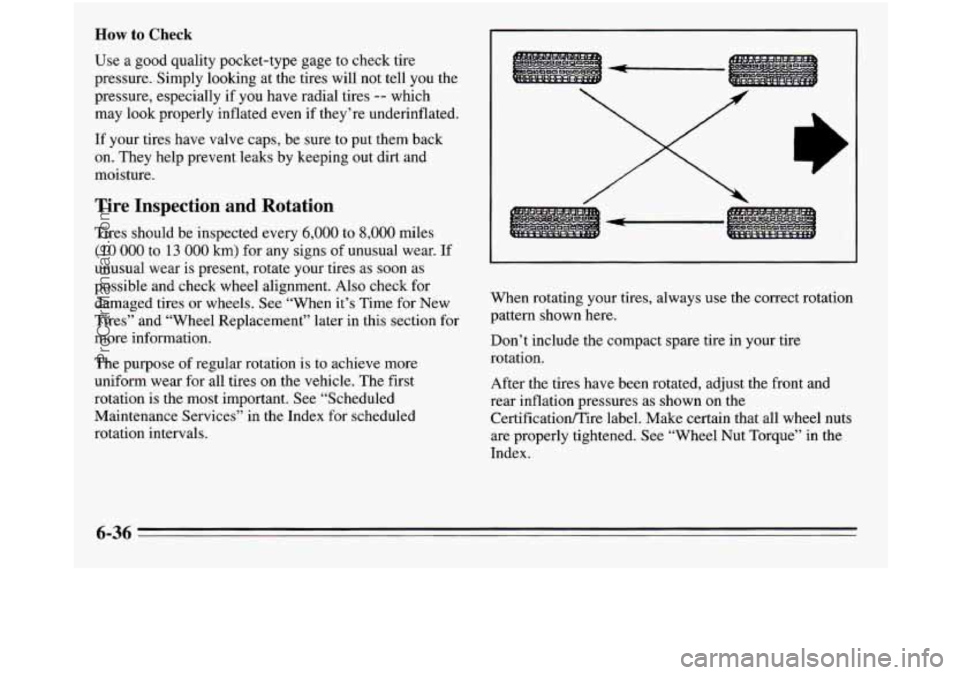
How to Check
Use a good quality pocket-type gage to check tire
pressure. Simply looking at the tires will not tell you the
pressure, especially if you have radial tires
-- which
may look properly inflated even if they’re underinflated.
If your tires have valve caps, be sure to put them back
on. They help prevent leaks by keeping out dirt and
moisture.
Tire Inspection and Rotation
Tires should be inspected every 6,000 to 8,000 miles
(1 0 000 to 13 000 km) for any signs of unusual wear. If
unusual wear is present, rotate your tires as soon as
possible and check wheel alignment. Also check for
damaged tires or wheels. See “When it’s Time for New
Tires” and “Wheel Replacement” later in this section for
more information.
The purpose
of regular rotation is to achieve more
uniform wear for all tires on the vehicle. The first
rotation is the most important. See “Scheduled
Maintenance Services” in the Index for scheduled
rotation intervals. When
rotating your tires, always use the correct rotation
pattern shown here.
Don’t include the compact spare tire in your tire
rotation.
After the tires have been rotated, adjust the front and
rear inflation pressures as shown on
the
Certificatioflire label. Make certain that all wheel nuts
are properly tightened. See “Wheel Nut Torque” in the
Index.
6-36
ProCarManuals.com
Page 308 of 390
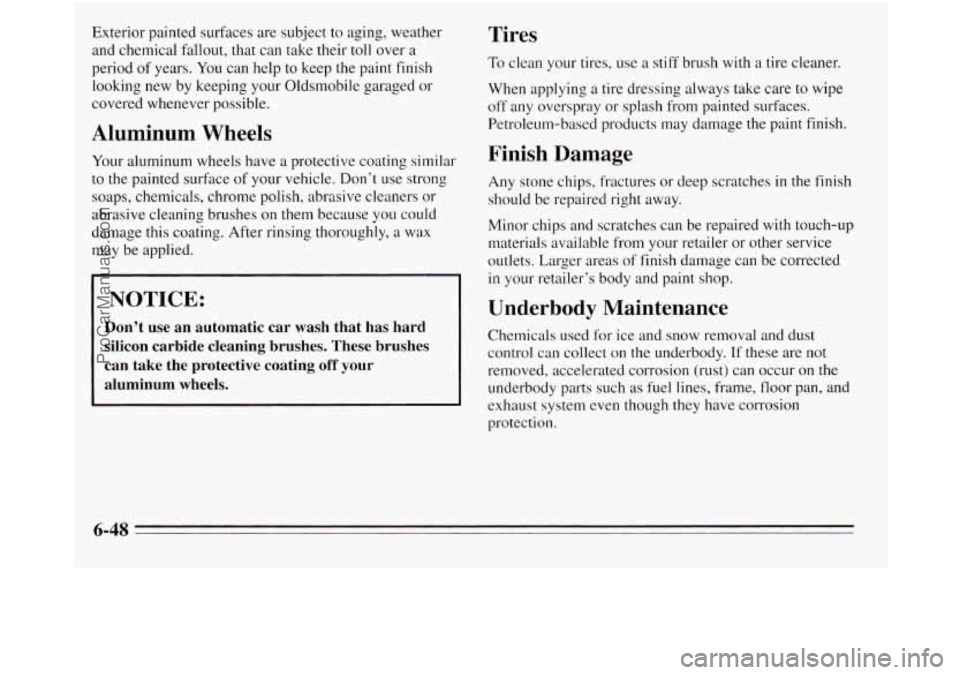
Exterior painted surfaces are subject to aging, weather
and chemical fallout, that can take their toll over
a
period of years. You can help to keep the paint finish
looking new by keeping your Oldsmobile garaged or
covered whenever possible.
Aluminum Wheels
Tires
To clean your tires, use a stiff brush with a tire cleaner.
When applying
a tire dressing always take care to wipe
off any overspray or splash from painted surfaces.
Petroleum-based products may damage the paint finish.
Your aluminum wheels have
a protective coating similar Finish Damage
to the painted surface of your vehicle. Don’t use strong Any stone chips, fractures or deep scratches in the finish
soaps, chemicals, chrome polish, abrasive cleaners or should be repaired right away.
abrasive cleaning brushes on them because yo~l could
damage this coating. After rinsing thoroughly,
a wax
may be applied. Minor
chips and scratches can be repaired with touch-up
materials available from your retailer or other service
outlets. Larger areas of finish damage can be corrected
in your retailer’s body and paint shop.
NOTICE: Underbody Maintenance
Don’t use an automatic car wash that has hard
silicon carbide cleaning brushes. These brushes
can take the protective coating
off your
underbody parts such as fuel lines, frame, floor pan, and aluminum wheels.
removed, accelerated corrosion (rust) can occur on the
Chemicals used
for ice and snow removal and dust
control can collect on the underbody. If these are not
exhaust system even though they have corrosion
protection.
6-48
ProCarManuals.com
Page 310 of 390
I i
Appearance Care and Maintenance Materials
Weatherstrips, Stops squeaks
6-50
ProCarManuals.com
Page 320 of 390

Engine Specifications
VIN Engine Code . . . . . . , . . . . . . . . . . . . . . . . . . . . . . . . . , . .
Type .............................................
Displacement . . . . . . . . . . . . . . . . . . . . . . . . . . . . . . . . . . . . . .
Compression Ratio . . . . . . . . . . . . . . . . - . . , . . . . . . . . . . . . . .
Firingorder .......................................
Thermostat Temperature Specification . . . . . . . , . . . . . . . . . .
3.1L V6 Engine
D
V6
3.1 Liters
8.5:
1
1-2-3-4-5-6
195
OF (91OC)
Normal Maintenance Replacement Parts
Air Cleaner Element . . . . . . . . . . . . . . . . . . . . . . . . . . . . . , . . . AC Type A-773C
Engine Oil Filter.
. . . . . . . . . . . . . . . . . . . . . . . . . . . . . . . . . . . AC Type PF-47
PCVValve
........................................ ACTypeCV-789C
Spark Plugs
, . . . . . . . . . , . . . . . . . . . . . . . . . . . . . . . . . . . . . . AC Type oR43TS
Remote Lock Control Battery (1)
. . . . . , . . . . . . . . . . . . . . . . CR2032
Gap: 0.045 inch
(1.14
mm)
3800 V6 Engine
1
V6
3.8 Liters
9.0:
1
1-6-5-4-3-2
195°F (91 "C)
AC Type A-974C AC Type PF-47
AC Type CV-892C AC Type 41-601
Gap: 0.060 inch (1.52 mm)
CR2032
6-60
ProCarManuals.com
Page 323 of 390
1 Section 7 Maintenance Schedule
IMPORTANT.
KEEP ENGINE OIL
AT THE PROPER
LEVEL AND CHANGE AS
RECOMMENDED
This section covers the maintenance required for your
Oldsmobile.
Your vehicle needs these services to retain its
safety, dependability and emission control performance.
I mm
I
Introduction
Your Vehicle and the Environment
Proper vehicle maintenance not only helps to keep your
vehicle
in good working condition, but also helps the
environment. All recommended maintenance procedures
are important. Improper vehicle maintenance
or the
removal
of important components can significantly
affect
the quality of the air we breathe. Improper fluid
levels or even the wrong tire inflation can increase the
level of emissions from your vehicle.
To help protect our
environment, and to help keep your vehicle in good
condition, please maintain your vehicle properly.
ProCarManuals.com
Page 324 of 390
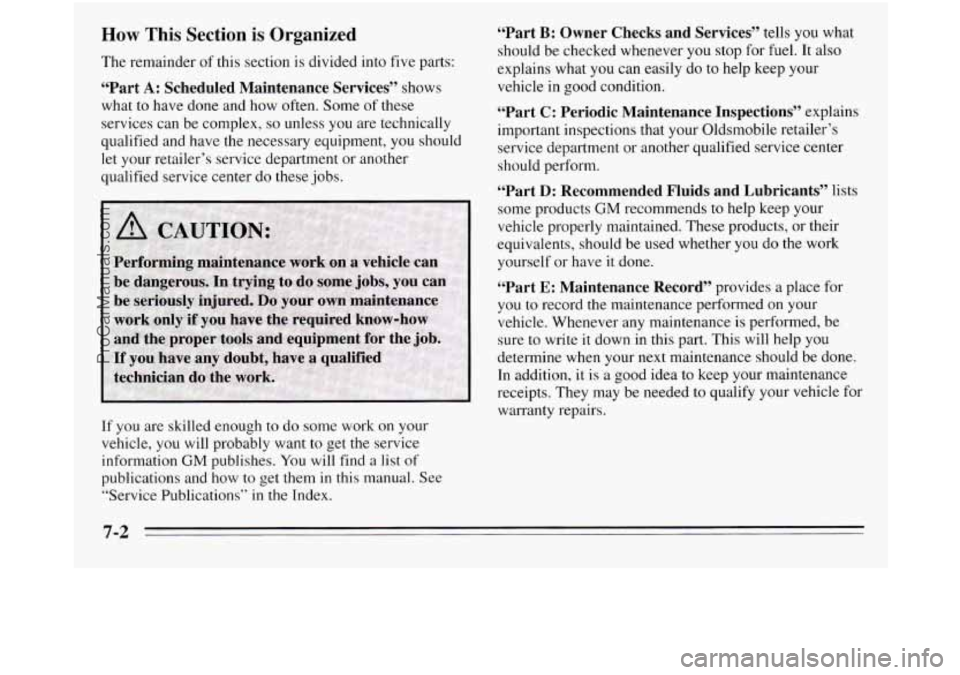
How This Section is Organized
The remainder of this section is divided into five parts:
“Part A: Scheduled Maintenance Services” shows
what
to have done and how often. Some of these
services can be complex,
so unless you are technically
qualified and have the necessary equipment, you should
let your retailer’s service department or another
qualified service center do these jobs.
If you are skilled enough
to do some work on your
vehicle, you will probably want to get the service
information
GM publishes. You will find a list of
publications and how to get them in this manual. See
“Service Publications”
in the Index.
“Part B: Owner Checks and Services” tells you what
should be checked whenever
you stop for fuel. It also
explains what you can easily do to help keep your
vehicle in good condition.
“Part C: Periodic Maintenance Inspections” explains
important inspections that your Oldsmobile retailer’s
service department or another qualified service center
should perform.
“Part D: Recommended Fluids and Lubricants” lists
some products
GM recommends to help keep your
vehicle properly maintained. These products,
or their
equivalents, should be used whether you do the work
yourself or have it done.
“Part E: Maintenance Record’’ provides a place for
you
to record the maintenance performed on your
vehicle. Whenever any maintenance
is performed, be
sure to write it down in this part. This will help you
determine when your next maintenance should be done.
In addition, it
is a good idea to keep your maintenance
receipts. They may be needed to qualify your vehicle for
warranty repairs.
7-2
ProCarManuals.com
Page 325 of 390
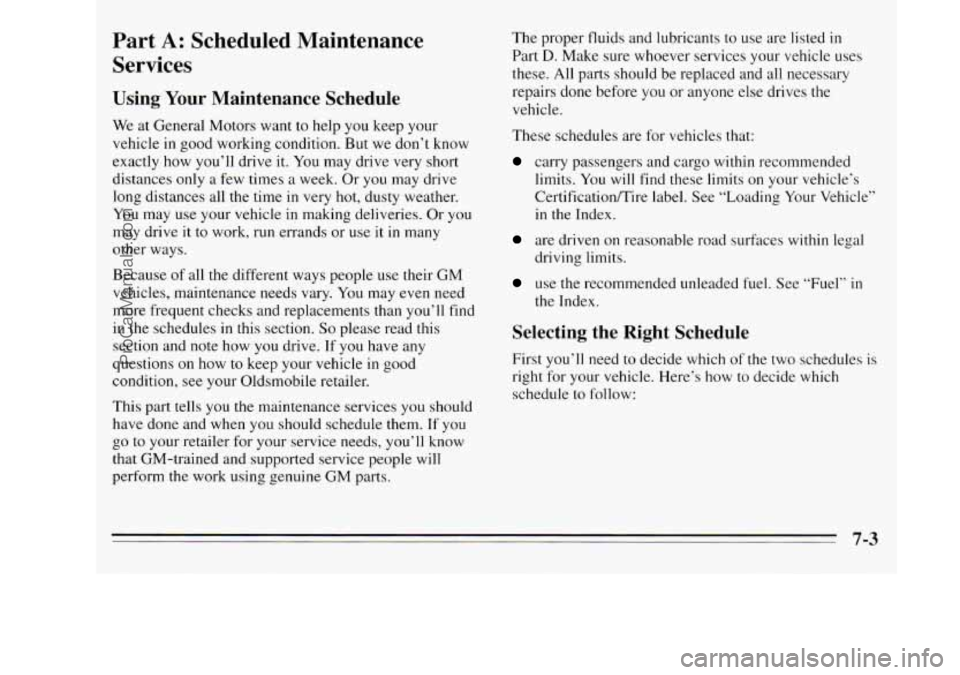
Part A: Scheduled Maintenance
Services
Using Your Maintenance Schedule
We at General Motors want to help you keep your
vehicle
in good working condition. But we don’t know
exactly how you’ll drive it. You may drive very short
distances
only a few times a week. Or you may drive
long distances all the time in very hot, dusty weather.
You may use your vehicle in making deliveries. Or you
may drive
it to work, run errands or use it in many
other ways.
Because of all
the different ways people use their GM
vehicles, maintenance needs vary. You may even need
more frequent checks and replacements than you’ll find
in the schedules
in this section. So please read this
section and note how you drive. If you have any
questions on how
to keep your vehicle in good
condition, see your Oldsmobile retailer.
This part tells you the maintenance services you should
have done and when you should schedule them. If you
go to your retailer for your service needs, you’ll know
that GM-trained and supported service people will
perform the work using genuine GM parts. The
proper fluids and lubricants to use are listed
in
Part D. Make sure whoever services your vehicle uses
these. All parts should be replaced and all necessary
repairs done before you or anyone else drives the
vehicle.
These schedules are for vehicles that:
carry passengers and cargo within recommended
limits. You will find these limits on your vehicle’s
Certification/Tire label. See “Loading Your Vehicle”
in the Index.
are driven on reasonable road surfaces within legal
driving limits.
use the recommended unleaded fuel. See “Fuel” in
the Index.
Selecting the Right Schedule
First you’ll need to decide which of the two schedules is
right for your vehicle. Here’s how to decide which
schedule to follow:
7-3
ProCarManuals.com
Page 326 of 390
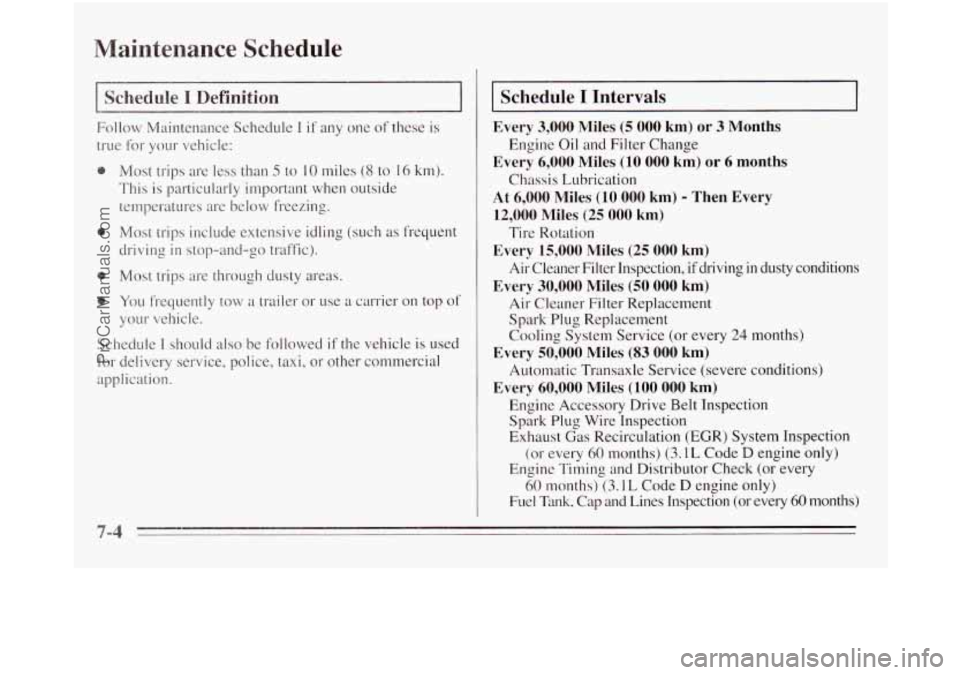
Maintenance Schedule
I Schedule I Definition I
Follow Maintenance Schedule I if any one of these is
true for your vehicle:
0 Most trips are less than 5 to 10 miles (8 to 16 km).
This is particularly important when outside
temperatures are below freezing.
0 Most trips include extensive idling (such as frequent
driving in stop-and-go traffic).
0 Most trips are through dusty areas.
0 You frequently tow a trailer or use a carrier on top 0.f
your vehicle.
Schedule
I should also be followed if the vehicle is used
for delivery service, police, taxi, or other commercial
application.
Schedule I Intervals
Every 3,000 Miles (5 000 km) or 3 Months
Engine Oil and Filter Change
Every 6,000 Miles (10 000 km) or 6 months
Chassis Lubrication
At 6,000 Miles (10 000 km) - Then Every
12,000 Miles (25 000 km)
Tire Rotation
Every 15,000 Miles (25 000 km)
Air Cleaner Filter Inspection, if driving in dusty conditions
Every 30,000 Miles (50 000 km)
Air Cleaner Filter Replacement
Spark Plug Replacement
Cooling System Service (or every
24 months)
Automatic Transaxle Service (severe conditions)
Engine Accessory Drive Belt Inspection
Spark
Plug Wire Inspection
Exhaust
Gas Recirculation (EGR) System Inspection
(or every
60 months) (3.1L Code D engine only)
Engine Timing and Distributor Check (or every
60 months) (3.1 L Code D engine only)
Fuel Tank, Cap and Lines Inspection
(or every 60 months)
Every 50,000 Miles (83 000 km)
Every
60,000 Miles (100 000 km)
7-4
ProCarManuals.com